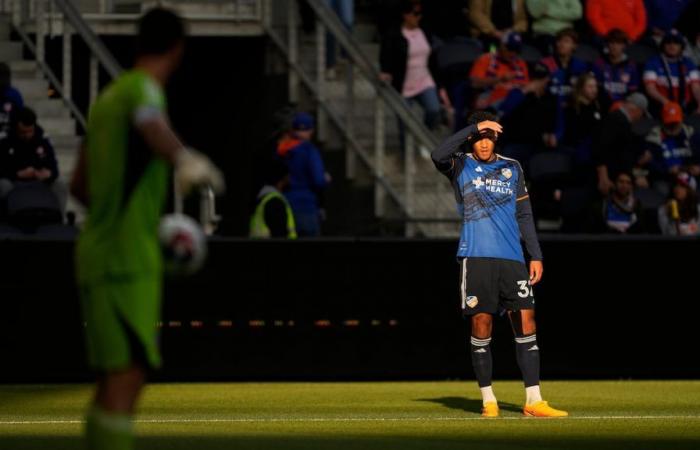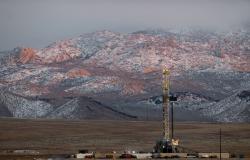
EL PAÍS offers the América Futura section openly for its daily and global information contribution on sustainable development. If you want to support our journalism, subscribe here.
When Argentina faces Canada this Thursday in the opening match of the Copa América, the United States will be immersed in a heat wave that will affect more than 77 million people. The roof of the Mercedes-Benz Stadium in Atlanta, the venue for the game, is probably closed to control the interior temperature of the high temperatures that the capital of Georgia is experiencing these days.
Although June 20 barely marks the official start of summer, temperatures in the city are already much higher than during the hottest periods of the year half a century ago. In 1974, the highest temperature recorded in Atlanta was 25 degrees; This Thursday, the city will be above 32 degrees Celsius.
In an increasingly hot planet, the South American Football Confederation (Conmebol) has issued for the first time in its history a series of directives to address exertional heat stroke in football. With this announcement, it joins sports organizations such as FIFA and the Premier League in implementing preventive measures against extreme heat events.
In the announcement, published last Tuesday, the governing body of South American football recognizes that “increasing temperatures due to climate change represent significant threats to players” and expresses “the organization’s commitment to player safety and climate awareness” in the face of “the seriousness of global warming.”
According to Osvaldo Pangrazio, president of the Medical Commission and director of the Conmebol Anti-Doping Unit, the guidelines, which were taken after analyzing “a record of the effects that heat can produce in some cities” seek to prevent “health problems such as hyperthermia, dehydration, and increased muscle injuries.” Their main concern is not the games, which are played in air-conditioned stadiums, but “the training sessions, both for the players and the refereeing team.”
To prevent players from suffering heat stroke during the Copa América, the organization will allow them to request breaks during the tournament, explains Pangrazio. If required, footballers may ask the referee for 90-second breaks to hydrate. In addition, the doctor recommends the use of towels with ice during rest.
One of the first heat waves of the season
The heat wave is expected to affect the Midwest and Northwest of the United States later this week. As of Tuesday morning, more than 77 million Americans were under extreme heat alerts. The United States Weather Service (NWS) estimates that certain areas of the country, such as the cities of Brownsville and Laredo, Texas, will exceed 41 degrees Celsius over the weekend. In Atlanta, where the opening game is played, temperatures on Saturday and Sunday will reach 36 degrees Celsius.
Heat waves in the US have increased in both frequency and severity in recent years. In June 2021, western North America experienced a record heat wave that not only recorded the highest temperatures in the region’s history, but also caused wildfires, the deaths of more than half a million animals, and severe damage to local crops. The US National Oceanic and Atmospheric Administration (NOAA) estimates that this event caused damage valued at approximately eight billion dollars. A study published in the scientific journal Science Advances concluded that, since 1960, there have only been five more extreme heat waves.
This week’s weather event is not expected to be as intense as 2021. However, this new heat wave will most severely affect Arizona, New Mexico, Florida, Nevada and Texas; Most of the Copa América matches will be played in these last three states.
“The weather report from this beginning of the week indicates that many areas will experience a heat wave that will not last long, but it will be important,” said Pangrazio, of Conmebol. “We are monitoring that system so that the team doctors take the necessary measures.”
How does the heat affect football?
“Heat always affects athletic performance,” says Leslie Mabon, professor of Environmental Systems at the Open University. Although the impact varies depending on the athlete’s physical condition, his age, his playing style and his role on the team.
In the case of Conmebol’s recommendations, they emphasize the prevention of heat stroke caused by exertion which, in the most severe instances, can cause death, even in young athletes. “The risk is greatest during training, in extreme heat conditions, especially in sporting communities where athletes are encouraged to push themselves to the limit,” says Mabon.
“When we consider heat stress, we must take into account both the heat generated internally by physical activity and the external heat from the environment,” says S. Tony Wolf, assistant professor in the department of kinesiology at the University of Georgia. .
In addition, he adds, we must add the impact of ambient humidity. “For sweat to cool us, it must evaporate. In a very humid environment, sweat remains on the skin or drips without evaporating, which makes it difficult to regulate body temperature.”
A sporting world that changes with the climate
Conmebol is not the only organization that is taking steps to integrate a response to the effects of climate change in football. FIFA, for example, indicates that a wet bulb globe temperature (WBGT) value above 32 degrees Celsius constitutes an “extreme risk of thermal injury.”
This parameter for measuring heat, Wolf points out, is more complete and gives a “more precise idea of the total thermal environment and its impact on heat dissipation through sweat,” since it considers the ambient temperature, humidity, solar radiation and air movement.
Under extreme heat conditions, FIFA suggests postponing the match or implementing breaks every 30 minutes so that players can hydrate and rest. This happened in the match between Mexico and the Netherlands during the World Cup in Brazil, when referee Pedro Proenca ordered the first hydration break due to the extreme heat of the stadium. The heat was also the reason why FIFA moved the Qatar 2022 World Cup from June to November.
The Premier League implemented similar measures in 2022, when the UK’s national weather service declared an extreme heat alert during one of the tournament weekends. In response, the English league required mandatory hydration breaks when temperatures exceeded 30 degrees Celsius.
However, organizations such as the International Federation of Professional Footballers have criticized these measures as insufficient. The association claims that FIFA guidelines, with only one break for each playing time, do not allow players to rest or hydrate properly.
The debate reveals a sporting world in search of answers to climate change. “Some organizations, such as the International Cycling Union, have created guidelines based on the WBGT to limit or cancel events. However, many of these measures are not completely evidence-based,” notes Wolf. “We need more research efforts to better understand what environmental conditions lead to increased risk.”
Mabon, for his part, believes that preventive measures can be effective, although their usefulness is limited. For example, Conmebol recommends that soccer players acclimatize to the heat for two weeks before matches, but since the Copa América will be played in 14 different cities, temperatures and conditions will change depending on the time, day and place where it is played. play.
“There are ways to adapt, such as training at cooler times of day, having cool-down breaks and playing early in the morning or late at night,” says the Open University Environmental Systems professor. “However, as the world warms, there is a limit to how much the human body can adapt.”





